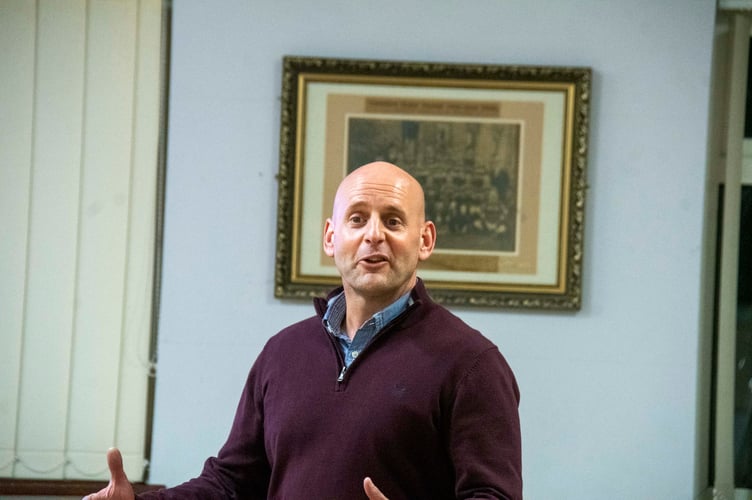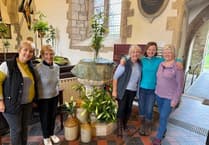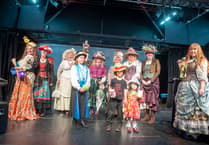
THE artificial turf pitch to be laid at Cinderford Rugby Club later this summer will be “among the best” playing surfaces in the country.
New floodlights being installed allow the club to host under-20 internationals and meet the criteria for Championship rugby, a launch event at the Beavis Memorial Ground was told.
The 3G pitch is part of a £1.5 million project being funded by club president Pete Bell.
It will also include an upgrade to the floodlights at the Dockham Road ground.
The initiative has been assisted by the expertise of former Cinderford player Phil Greenaway and Jason Douglas who has worked on projects from grassroots clubs to the London 2012 Olympics.
The issue of the pitch was first raised at a reunion of Cinderford players a few years ago, said Mr Bell, who has been involved with the club since he was 15.
More serious discussions took place with club treasurer Rob Beavis last year and was brought into focus when Cinderford played Birmingham side Moseley last year.
“We were a bit early and so we were informed by DoR (Director of Rugby) Paul Morris to go and watch the juniors play
“I watched the enthusiasm of all the parents, and the volunteers and the kids playing and wonderful time they were having but kept hearing these stories of the disappointment when our kids and our ladies and our junior sides couldn't play on and I thought ‘we need to seriously try and do something about it.’
The vision for me was pretty simple. It's not just about chucking in a lump of money and walking away.
“It's about how we make our club more sustainable.
First of foremost, it was all about creating an environment where our kids can play rugby all the time, our senior teams can play rugby all the time and we can then generate some income and and make it sustainable going forward.
“For me, it's all about sustainability, because if we can't sustain the club in the finances, we probably won’t be here in 10 years time because we couldn't afford to run the club. and that's the same problem that every club up and down the land faces..
“We’ve started the process and I didn't realise how much time it would take of my life .
We thought we could get over the line without needing to get planning permission.”
It had been hoped the project could be done without needing planning permission but the club was told it would have to get clearance from the Forest Council.
Mr Bell said: “I have to say, every politician, every councillor, everyone involved, even the planning officers were very, very supportive of what we wanted to achieve, but we had to go through a rigorous process.
“This is all about keeping this club vibrant, its about the kids, the girls the men and the sustainability of the rugby club.
I I firmly believe that by building a 3G pitch, Cinderford can still out-scrummage someone, they can still catch and drive, but I think we can play a more expansive game of rugby because we are in the game of entertaining.
“We do have to entertain people because when people come through the gates, they want to see tries, they don't want to see a boring game in the mud with no off-loads, no breaking tackles, they want to see excitement – we’re going to deliver that.
“Friday night games under the best lights you’ve seen, two games on the Saturday, kids on Sunday, training Tuesday and Thursday and the rest of the week renting it out.
Let’s make this club the vibrant hub it was when I was playing rugby here.”
Phil Greenaway, who played for Cinderford between 2004 and 2010, said he had a chat with Rob Beavis about “what the future of Cinderford Rugby Club might look like.”
He said the initial work involved “stress-testing” the club.

“We spoke to a lots of contractors, we went to lots of people about planning, all those bits and pieces to find out if this was the right decision for the club.
“Our job initially was to do was to ask these guys lots and lots of questions and ask the market, ask the industry lots and lots of questions about what products were on the market and what was right for Cinderford.
We did a feasibility study and impact study, and through that we have looked at absolutely everything: the proposal, the rationale, the size of the pitch, the floodlights, absolutely everything.
“We’ve also done a map of all the local users in the local area (for) potential commercial revenues.
“We've looked at project when the carpet will need to relaid in 10 years time.
“Wrapped up in everything we've done are the operational considerations and that probably took about three or four months to pull our feasibility study together.
“It's been a huge amount of work to get to there. as part of that we did engage with sub contractors to give us some idea of what it might look like.”
“We really stress-tested the club to make sure it's the right for everybody in Cinderford and the local rugby club and the local community as well to try and make sure everybody is considered whether that be a local disability walking group who use the pitch on a Monday, whether that be kids on a Wednesday night, two games on Saturday, game on Friday night, the local university using it or hosting Sevens tournaments in the summer.
“We looked at absolutely everything to make sure it was going to leave the club in really good stead.
He said in terms of planning aspects, “the team we used from Pete’s (KW Bell) group guys were absolutely sensational.
“The nice thing about this project is everybody's local which means they've got an in to the club and it is a passion project.
“The art of building a good pitch is you go from the bottom up.
“We worked with the lots companies to make sure we have the right solution.
“Because this was a privately-funded investment from Pete we could be more creative in terms of what we're doing in terms of sustainability.
“It meant we could really challenge the market to give us their best and that's what we did.
“It was a really, really robust tender process. “Lots of to-ing and fro-ing from contractors, from design solutions to irrigation tanks and the lux of the floodlights and drainage to make sure we are future-proofing the club.
“We were really challenging those guys to give us their absolutely best, because that's what we thought people of Cinderford deserve.”
Consultant Jason Douglas said the club had not just gone for the cheapest option.
“It's a big investment. and there are ways to develop a 3D pitch, which would give you a 3G pitch that would do the job.
“But what we're embarking on as a result of the commitment to this club by these people, probably if not the best pitch in the country, then one of the best pitches in the country.

“The product we’re is installing here is at the very, very top end of what the market has to offer.
“The latest technology and the highest quality materials.
“We have introduced specialist maintenance equipment, which will be vital to making sure that the pitch stays in the optimum condition.
It needs to be in from the youngest players to the most senior players.
For every 10 hours of pitch use, we will be out there power sweeping the pitch .
“We will be making sure that the pitch.is in the same condition in years two, three four, five six seven as it was on day one.”
Asked about injuries, Mr Douglas said that while working with Championship side Coventry, it was found that while the rate of injury did not increase, the type did.
“What they found is, because the pace of the game increases, because the quality of the pitch underfoot was more consistent in every area of pitch, the the contacts level went up a bit.
“So we were seeing a little bit more of those impact injuries.”
He was also asked asked about burn injuries but said a combination of the under-surface infill and regular watering meant that would not be an issue at Cinderford.
The Cinderford pitch will be a pinewood-derived organic infill which will retain and reflect less heat than the more common black, rubber granules.
At the other end of the scale it may be possible to play on frosty days.
“The artificial fibres are hydrophobic, so they will hold on their outside a degree of moisture.
“There is a risk that will freeze but won't be in any way detrimental to the artificial grass itself.
“Sometimes, the best thing you can do is play on the surface, because every time a player runs around and moves around on the surface, it is helping break up and and distribute some of that, that frost risk.
“Playing on the surface where it’s frosty is a judgment call from the coaching staff and the referee.
“One of the best things you might want to do in that situation is take that maintenance machine and drag brush your pitch to break up the surface a little bit.”
The company that install the pitch – expected to be in July – is South Wales Sportsgrounds, based in Magor near Newport and who have done work for the Welsh Rugby Union, the Football Association of Wales and universities in the region.
“From the outset they were showing us this was a project that were really interested in.
“All the way through the process of defining the design, refining the cost plan demonstrating capability they were head and shoulders above everybody else, both in their eagerness to work with the club, their eagerness to understand the project which is critical and why project is getting done in the first place.
“They weren’t the cheapest contractor and I'll refer you back to my point: this pitch is not the cheapest pitch you can buy on the market.
“This gentleman here (Mr Bell) is making decisions around what is best for this club, not what's the cheapest he can get away with.”
He said the “spectator experience” would also be improved with new fencing and a hard-standing footpath all the way around the pitch.
Mr Douglas added that the new pitch would be as “environmentally conscientious” as possible.
“We are recovering all of the water that falls on that pitch and we're going reuse it in the irrigation system.
“The artificial grass itself is made from a carbon neutral or zero process.
“And the infill is an organic infill. If some of that infill gets outside the pitch, it is in no way detrimental to the environment outside.
“A really important part of the exercise was to make sure that what we ended up with was that the best possible surface we could, which will host the highest standard of rugby than we can.”
Mr Douglas said there was a two-metre difference in the height of the pitch across the diagonal.
“We're making the pitch completely flat across it’s surface.
“You’re not only going to get a fantastic surface, you’re also getting a snooker table.”
As part of the decision-making process a large contingent from Cinderford went to see the proposed surface in action at Derby Rugby Club.
Mr Bell said it was a “fantastic” surface that showed no sign of the flood that had occurred a month before.
Mr Greenaway added: “Artificial pitches can feel quite bouncy, whereas the surface at Derby and the system that will be used here feel very much like like a September pitch.
“The players who were there felt exactly the same.”
He added: “It’s been an absolute to work with the team and be part of something that is going to add so much to the community here.”





Comments
This article has no comments yet. Be the first to leave a comment.